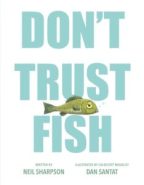 School Library Journal: What makes a good unreliable narrator… in a picture book? One might argue that it’s very much the same qualities that make a good unreliable narrator in a work of fiction for older readers. There’s the choice the author must make as to whether or not to show their hand early or leave the reveal right up until the end. Then there are all the little details that appeared earlier in the book, leaving the reader to doubt everything they were told. That may sound a little heavy for a title whose intended audience is probably still a little unclear on the whole tying-your-shoes deal, but believe me when I say that when it comes to a book like Don’t Trust Fish, I feel inclined to pull out all my literary criticism tips and tricks. There are some picture books that you read that make you chuckle when you see the cover. There are some picture books where they might get one legitimate laugh out of the adult reader. There are some picture books that are funny to young readers. Now consider a book that makes everybody, and I do mean everybody, laugh from the cover onwards. THAT, my friends, is a picture book worth celebrating! That is a rarity! That… is I Don’t Trust Fish.
School Library Journal: What makes a good unreliable narrator… in a picture book? One might argue that it’s very much the same qualities that make a good unreliable narrator in a work of fiction for older readers. There’s the choice the author must make as to whether or not to show their hand early or leave the reveal right up until the end. Then there are all the little details that appeared earlier in the book, leaving the reader to doubt everything they were told. That may sound a little heavy for a title whose intended audience is probably still a little unclear on the whole tying-your-shoes deal, but believe me when I say that when it comes to a book like Don’t Trust Fish, I feel inclined to pull out all my literary criticism tips and tricks. There are some picture books that you read that make you chuckle when you see the cover. There are some picture books where they might get one legitimate laugh out of the adult reader. There are some picture books that are funny to young readers. Now consider a book that makes everybody, and I do mean everybody, laugh from the cover onwards. THAT, my friends, is a picture book worth celebrating! That is a rarity! That… is I Don’t Trust Fish.
There are animals in this world that you can rely on. It has fur, is warm-blooded, and feeds its babies milk? That’s a mammal. Cold-blooded with scaly skin and lays eggs? Reptile. Feathers? Birds. Easy peasy. Then… there are fish. Fish don’t follow the usual rules, so you know what that means? “Don’t trust fish!” Don’t trust ‘em! Thanks to this book, you will learn the myriad reasons not to trust these sneaky denizens of the deep. Whale sharks? They’re the size of buses. “That is not okay”. Fish watch us. They plan. They scheme. With scintillating details and delightful art, young readers are given ample reasons not to trust our underwater brethren. But who, precisely, is imparting this information?